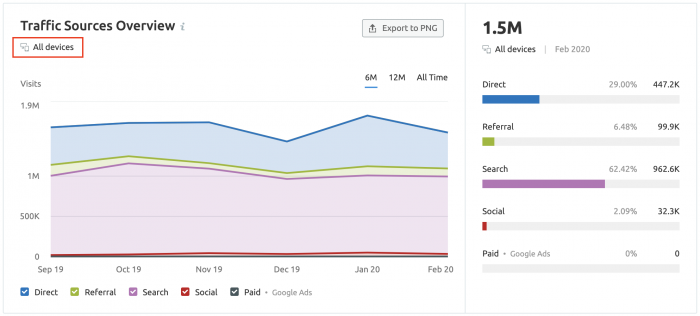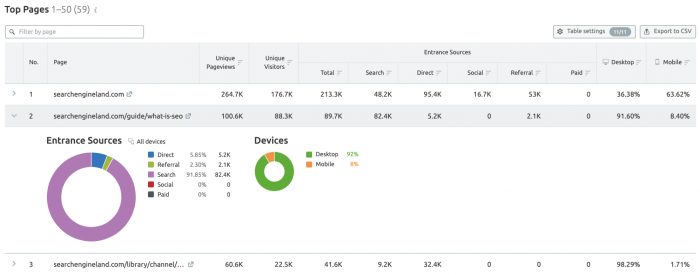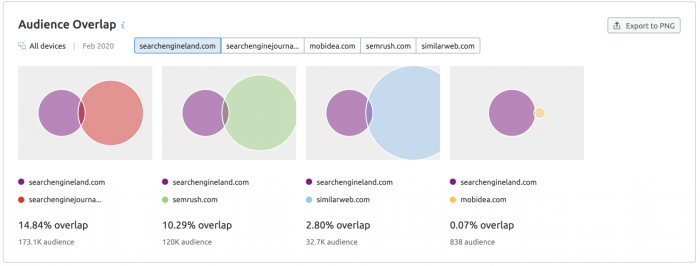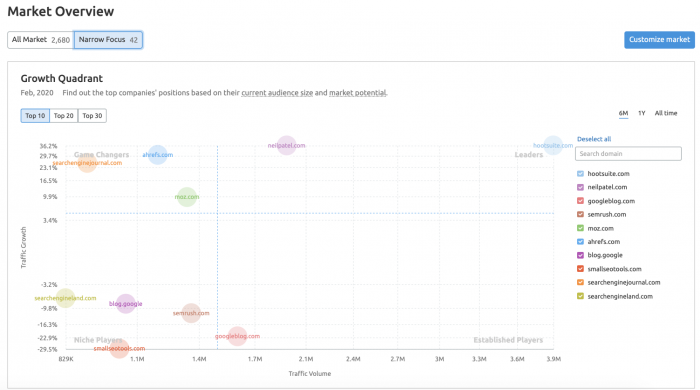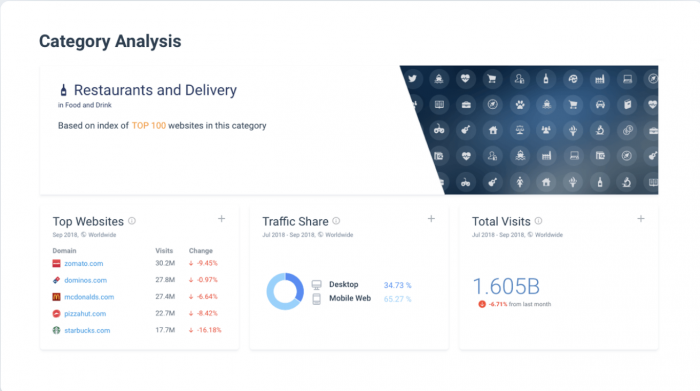SimilarWeb vs SEMrush Traffic Analytics – Website Traffic Comparison
Last updated on May 4, 2021 by João Aguiar 8 min readAny self-respecting marketer is a journalist, in a sense.
Meaning they check and double-check any information that comes up on their radar.
Verified data makes credible argumentation and a lasting reputation. It’s all clear; the only question is how can you get (or make) such irrefutable material?
If you’ve got an accurate tool, you’re on to a winner.
Let’s have a look at two titans of website traffic analysis — SEMrush Traffic Analytics and SimilarWeb — and see if one of them can make a dependable data provider for your marketing campaigns.
For each criterion, we will give one point to the winning tool. Among other things, we will consider if SEMrush Traffic Analytics and SimilarWeb are worth their prices.
SimilarWeb vs SEMrush – Detailed Comparison
In this review, we focus on the tools’ website traffic analysis capabilities. The metrics involved are key indicators of a company’s digital marketing performance. Normally, these rates are the first to be researched.
SEMrush Traffic Analytics comes from a comprehensive online visibility suite that also owns tools for SEO specialists, PPC advertisers, social media and content marketers.
In contrast, SimilarWeb is intended solely for website statistics.
Which product strategy wins?
Let’s judge by specific features, data, accuracy, and pricing. We’ll be giving one point to the tool that leads in a chosen category/characteristic.
SimilarWeb vs SEMrush – Features
Let’s dive into each feature of both tools so we can find the best traffic analytics tool!
Global and Regional data
SEMrush Traffic Analytics offers full access to traffic stats from 190 countries, with the ability to filter by location. All the regions are available in one subscription.
SimilarWeb also possesses data across a whole range of territories but offers access only to purchased databases. At that, each country’s database is priced separately.
1:0 to SEMrush Traffic Analytics
Detailed Traffic Sources Analysis
The main types of traffic — direct, organic search, referral, paid search, and social — are covered by both tools.
In addition to a traffic sources overview, SEMrush Traffic Analytics can help you gain insights into how a website actually generated all these visits from each channel.
You can even gain insight into what sources led traffic to specific pages of a domain (with the Top Pages feature of the tool).
In addition, you can benefit from the general SEMrush subscription and reveal the researched company’s advertising campaigns, keyword strategy, and content across the media. For all these advantages, SEMrush makes its honest point.
At that, SimilarWeb provides a more detailed analysis of the traffic sources at a basic level. The tool also gains a point in this round for offering data on two additional channels: display ads and emails.
2:1 to SEMrush Traffic Analytics
Traffic to the Most Popular Pages
SimilarWeb used to have a feature called Popular Pages that ranked inner pages by their page views’ share. Recently, the feature has been made unavailable to a wider audience.
Meanwhile, SEMrush Traffic Analytics has a detailed Top Pages report, giving you a list of the most visited pages on a website, counting both internal and external visits. You can filter the ranking by unique pageviews, unique visitors or entrances and also have a look at the entrance sources.
Sounds like this feature can lead you to some insightful conclusions and bring another point to the SEMrush tool.
3:1 to SEMrush Traffic Analytics
Mobile Data
In SEMrush Traffic Analytics, mobile traffic data is fully available.
In SimilarWeb, it needs to be purchased separately.
Considering that marketing spending on mobile is expected to grow by 70% over the next five years, we are tempted to give more than one point to SEMrush Traffic Analytics. But rules are rules, and we add one to the tool’s score.
4:1 to SEMrush Traffic Analytics
Audience Analysis & Demographics
With SEMrush Traffic Analytics, you can check the audience overlap between any websites. The subscription also includes the new Market Explorer tool, which helps you discover demographics (age and gender) and interests of the in-market audience. The features also allow you to discover similar websites.
With SimilarWeb, you can analyze audience demographics, interests, and geo. You will get to see similar websites in the tool, too.
However, the audience overlap remains unaddressed. The tool misses another chance to gain a point.
5:1 to SEMrush Traffic Analytics
Industry/Category Analysis
The closest that SEMrush gets to industry analysis is with its Market Explorer. It’s a separate tool where you can see a list of relevant websites, similar to the one you enter.
Supposedly, driven by the tool’s algorithms, these domains belong to players aimed at the same market and working in the same industry.
Moreover, they’ve recently introduced a new feature in Market Explorer that evaluates market players’ growth rate along with their current audience size.
It’s visually comprehensible, and we see it equally insightful for new market research and competitive benchmarking.
In SimilarWeb, industry analysis is crystal clear. You can check category performance, traffic share, and leaders of the industry, and benchmark yourself against these metrics.
However, the tool doesn’t assess single players’ pace of growth.
Noting the fact that SEMrush has more capacity and their extra feature is included in the price of Traffic Analytics, we give a point to SEMrush.
6:1 to SEMrush Traffic Analytics
Historical data
Metrics for past periods are accessible on any SEMrush subscription since April 2016.
In SimilarWeb, the available data range depends on subscription: the basic one includes only 12 months.
7:1 to SEMrush Traffic Analytics
API Access
Both tools allow you to use API for whatever reason you need it.
SEMrush Traffic Analytics offers API access independently from the interface subscription, which means you don’t have to buy Traffic Analytics if you only need this data for your custom reports or integration to your product. In general, data is arranged in a more user-friendly way than in SimilarWeb.
For example, to receive all the main stats on a domain, you need to make just one query, while in SimilarWeb, it takes three queries. Limit-wise and effort-wise, this is more efficient.
What truly makes SimilarWeb different is their comprehensible UI. You can clearly see how many API units you have spent and how many you have left.
There are even special Similar Websites API and Adult Websites API. So, overall, you can get more data with SimilarWeb API.
7:2 to SEMrush Traffic Analytics (yes, nevertheless, they are still leading!)
Accuracy
As both tools use similar algorithms of clickstream data collection, projection, and estimation, a discrepancy is inevitable.
And, of course, if you start analyzing your own domain with either SEMrush Traffic Analytics or SimilarWeb and then comparing stats with what you see in Google Analytics, you will see the difference in numbers.
The question is, how big is this discrepancy?
Before we present you with what we’ve found out, we want to emphasize one thing: both traffic analytics tools were made for the competitive analysis that always tells the most when it is comparative.
So, make sure you use the investigated data for comparing rivals with each other, benchmarking, and identifying trends.
To check the tools’ accuracy, we sent an anonymous poll around our community, asking people to share their websites’ monthly traffic, and then compared these numbers with what SEMrush Traffic Analytics and SimilarWeb showed.
The numbers in the table show the difference between what we learned from the website owners and what SEMrush Traffic Analytics and SimilarWeb showed.
The smaller the error, the higher the accuracy.
| Website Popularity | SEMrush Error (%) | SimilarWeb Error (%) |
| 0-10K visits | 74 | n/a |
| 10K-50K visits | 57 | 80 |
| 50K-150K visits | 41 | 40 |
| 150K-500K visits | 33 | 35 |
| Over 500K visits | 36 | 37 |
We see that SEMrush Traffic Analytics does a way better job than SimilarWeb in analyzing smaller domains.
For higher populated sites, the tools are practically neck-and-neck.
We pay our extra respects to SEMrush Traffic Analytics, which has the “Estimated accuracy” sign at the top of the interface.
The larger the audience of an analyzed website, the higher the accuracy, the tooltip indicates, and our findings prove it.
Don’t be scared by the fact that discrepancy exists at all: as this possible error is applied to all the researched competitors’ domains, it shouldn’t distort the picture if you compare them with each other.
8:2 to SEMrush Traffic Analytics
SimilarWeb vs SEMrush – Pricing
What can be more objective than numbers? So no offense.
All features for website traffic analysis included in the SEMrush Traffic Analytics tool, all regional databases, and historical info are available for $200/month.
You get all the benefits mentioned in this article, including the unbeatable keyword database, by adding any SEMrush subscription — so, the price for the entire package will start from $299.95/month.
Most importantly, the price will be the same for every market.
SimilarWeb has a more complicated payment scheme. Each country database must be purchased separately, and many features (top pages, mobile data, etc.) also need to be paid for individually.
Even the basic package is expensive and has no fixed price.
9:2 to SEMrush Traffic Analytics
Which Tool to Choose for Website Traffic Analysis?
All in all, we can’t stop you from acquiring SimilarWeb or SEMrush if this is what you or your company is used to paying for.
However, if you are looking to use your money and time resources more efficiently, it may make more sense to subscribe to SEMrush Traffic Analytics.
This way, you will get more for less. You could also add a general SEMrush subscription to your toolkit if, apart from seeing the bigger picture, you need a detailed analysis of digital marketing channels.
And this would be one of the many more data-based decisions in your career.
Read next:

João Aguiar
Head of Digital at Mobidea
João is the Editor-in-Chief at Mobidea Academy, a tech player, dynamic, proactive, and fun! When he's not focusing on his role, he enjoys eating tasty food.
This SEO case study is gonna show you how to effectively dominate Google by focusing on a wonderfully successful SEO tactic!
ExoClick is one of the top adult ad networks where you can get awesome traffic! Read our ExoClick review and find out why!
Editor's note: Go2mobi is no longer available. Check this Go2mobi review and understand how to make money on Go2mobi like an expert!

